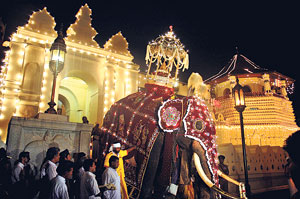| Gaveshaka discusses the Esala pageant
What you see in the Kandy Perahera
 As the sound of the 'kasa karayas' (whip crackers) is heard, the crowd gets excited. They had come from far and near, hours ahead to occupy a vantage point from where they can view the grandest pageants of all – the Sri Dalada Perahera – held every year in the hill capital during the month of Esala (August). As the sound of the 'kasa karayas' (whip crackers) is heard, the crowd gets excited. They had come from far and near, hours ahead to occupy a vantage point from where they can view the grandest pageants of all – the Sri Dalada Perahera – held every year in the hill capital during the month of Esala (August).
That's why the pageant is called the 'Esala Perahera.' The pavement along the lake bund is the most popular area where the crowds prefer to gather. That gives the closest view and the airy environment makes it comfortable to sit and wait for hours in anticipation.
In the days of the Kandyan Kingdom, the whip crackers were in the service of the Adigars (ministers) who were looking after territories allocated to them. Whenever the Adigars went somewhere, the whip crackers heralded their approach.
The whip crackers take part only in the Randoli Perahera – the more glamorous procession which takes to the streets during the last five days. They do not take part in the Kumbal Perahera.
Looking at what the whip crackers do to create the sound from the whips they carry, the task looks easy. But it's not as easy as that. There is an art in how they do it.
The flag-bearers walk after the whip crackers carrying flags of the different provinces and temples. Dressed in white national costume they march in single file on either side of the road.
Officials attached to the Maligawa from ancient times take part in the Perahera. They ride the elephants unlike the Nilames who walk clad in their traditional garb.
The first to ride an elephant in the Perahera is the Peramune Rala. Originally he carried the mandate from the king giving permission to hold the Perahera. Now he carries an ola manuscript with a list of the lands belonging to the Maligawa as well as the names of tenants and the services they have to render. This register is known as the lekam mitiya.
A bevy of drummers
follows playing martial music using several types of drums like the dawula, tammettama and bera. The horanewas (flutes) accompany the drums. The drummers move in a rhythmic pattern making it a beautiful sight.
The symbol of authority to hold the procession is a silver goad (ankusa) which is carried by the Gajanayaka Nilame, who rides an elephant after drummers. In the time of the Sinhala kings, he was a high official and was in charge of the king's
elephant stables.
The Kariya Korale is the official who wields authority in the Maligawa administration next to the Diyawandana Nilame. He is responsible for all the ceremonies connected with the Maligawa. He walks in the procession accompanied by minor temple functionaries, drummers and dancers.
The moment long awaited by the crowds arrives when the Maligawa tusker carrying the Maligawa karanduwa (golden casket) is sighted. They all sit up and with folded hands start chanting “sadhu, sadhu” in unison no sooner the tusker is sighted. The tusker walks majestically in keeping with the onerous task it performs, in carrying the casket, which houses the sacred Tooth Relic of the Buddha. A canopy is held over the casket and the tusker walks on pavada – the white cloth spread in front as a mark of respect. Attendants of two elephants on either side of the tusker keep throwing white flowers at the casket symbolizing offerings to the Relic.
Two lines of dancers facing each other on either side of the road accompanied by drummers in the middle precede the Diyawadana Nilame – the lay custodian of the Relic – who walks slowly accompanied by minor officials. Clad in the traditional costume with glittering ornaments, he is the cynosure of all eyes being the chief official of the Temple of the Tooth.
That ends the Maligawa procession which is followed by the dewala peraheras starting with the Natha Dewala Perahera. It is followed by processions representing the Maha Vishnu Dewala, the Kataragama Dewala and the Pattini Dewala processions. The head of each Dewala – the Basnayaka Nilame – walks in the respective procession with other officials.
Coming at the end of the long procession are the randolis – palanquins used by the queens during the time of the Kandyan kings – to travel about. |
|

 As the sound of the 'kasa karayas' (whip crackers) is heard, the crowd gets excited. They had come from far and near, hours ahead to occupy a vantage point from where they can view the grandest pageants of all – the Sri Dalada Perahera – held every year in the hill capital during the month of Esala (August).
As the sound of the 'kasa karayas' (whip crackers) is heard, the crowd gets excited. They had come from far and near, hours ahead to occupy a vantage point from where they can view the grandest pageants of all – the Sri Dalada Perahera – held every year in the hill capital during the month of Esala (August).